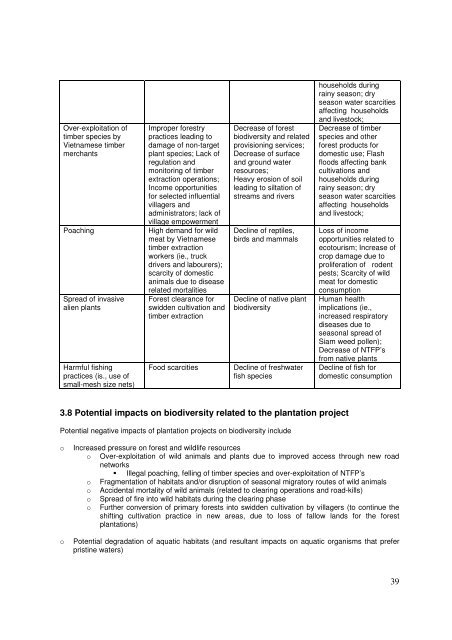Part 1 – A Rapid Participatory Biodiversity Assessment - IUCN
Part 1 – A Rapid Participatory Biodiversity Assessment - IUCN
Part 1 – A Rapid Participatory Biodiversity Assessment - IUCN
Create successful ePaper yourself
Turn your PDF publications into a flip-book with our unique Google optimized e-Paper software.
Over-exploitation of<br />
timber species by<br />
Vietnamese timber<br />
merchants<br />
Improper forestry<br />
practices leading to<br />
damage of non-target<br />
plant species; Lack of<br />
regulation and<br />
monitoring of timber<br />
extraction operations;<br />
Income opportunities<br />
for selected influential<br />
villagers and<br />
administrators; lack of<br />
village empowerment<br />
Poaching High demand for wild<br />
meat by Vietnamese<br />
timber extraction<br />
workers (ie., truck<br />
drivers and labourers);<br />
scarcity of domestic<br />
animals due to disease<br />
Spread of invasive<br />
alien plants<br />
Harmful fishing<br />
practices (is., use of<br />
small-mesh size nets)<br />
related mortalities<br />
Forest clearance for<br />
swidden cultivation and<br />
timber extraction<br />
Decrease of forest<br />
biodiversity and related<br />
provisioning services;<br />
Decrease of surface<br />
and ground water<br />
resources;<br />
Heavy erosion of soil<br />
leading to siltation of<br />
streams and rivers<br />
Decline of reptiles,<br />
birds and mammals<br />
Decline of native plant<br />
biodiversity<br />
Food scarcities Decline of freshwater<br />
fish species<br />
households during<br />
rainy season; dry<br />
season water scarcities<br />
affecting households<br />
and livestock;<br />
Decrease of timber<br />
species and other<br />
forest products for<br />
domestic use; Flash<br />
floods affecting bank<br />
cultivations and<br />
households during<br />
rainy season; dry<br />
season water scarcities<br />
affecting households<br />
and livestock;<br />
Loss of income<br />
opportunities related to<br />
ecotourism; Increase of<br />
crop damage due to<br />
proliferation of rodent<br />
pests; Scarcity of wild<br />
meat for domestic<br />
consumption<br />
Human health<br />
implications (ie.,<br />
increased respiratory<br />
diseases due to<br />
seasonal spread of<br />
Siam weed pollen);<br />
Decrease of NTFP’s<br />
from native plants<br />
3.8 Potential impacts on biodiversity related to the plantation project<br />
Potential negative impacts of plantation projects on biodiversity include<br />
Decline of fish for<br />
domestic consumption<br />
o Increased pressure on forest and wildlife resources<br />
o Over-exploitation of wild animals and plants due to improved access through new road<br />
networks<br />
� Illegal poaching, felling of timber species and over-exploitation of NTFP’s<br />
o Fragmentation of habitats and/or disruption of seasonal migratory routes of wild animals<br />
o Accidental mortality of wild animals (related to clearing operations and road-kills)<br />
o Spread of fire into wild habitats during the clearing phase<br />
o Further conversion of primary forests into swidden cultivation by villagers (to continue the<br />
shifting cultivation practice in new areas, due to loss of fallow lands for the forest<br />
plantations)<br />
o Potential degradation of aquatic habitats (and resultant impacts on aquatic organisms that prefer<br />
pristine waters)<br />
39

















